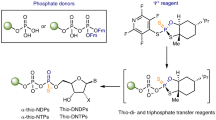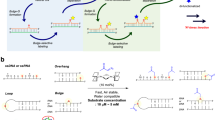Abstract
Emerging trends in drug discovery are prompting a renewed interest in natural products as a source of chemical diversity and lead structures. However, owing to the structural complexity of many natural compounds, the synthesis of derivatives is not easily realized. Here, we demonstrate a conceptually new approach using oligonucleotides as aptameric protective groups. These block several functionalities by non-covalent interactions in a complex molecule and enable the highly chemo- and regioselective derivatization (>99%) of natural antibiotics in a single synthetic step with excellent conversions of up to 83%. This technique reveals an important structure–activity relationship in neamine-based antibiotics and should help both to accelerate the discovery of new biologically active structures and to avoid potentially costly and cumbersome synthetic routes.
This is a preview of subscription content, access via your institution
Access options
Subscribe to this journal
Receive 12 print issues and online access
$259.00 per year
only $21.58 per issue
Buy this article
- Purchase on Springer Link
- Instant access to full article PDF
Prices may be subject to local taxes which are calculated during checkout


Similar content being viewed by others
References
Koehn, F. E. & Carter, G. T. The evolving role of natural products in drug discovery. Nature 4, 206–220 (2005).
Li, J W-H. & Vederas, J. C. Drug discovery and natural products: end of an era or an endless frontier. Science 325, 161–165 (2009).
Alper, P. B., Hendrix, M., Sears, P. & Wong, C-H. Probing the specificity of aminoglycoside–ribosomal RNA interactions with designed synthetic analogs. J. Am. Chem. Soc. 120, 1965–1978 (1998).
Usui, T. & Umezawa, S. Total synthesis of neomycin B. Carbohydr. Res. 174, 133–143 (1988).
Hanessian, S., Szychowski, J., Campos-Reales Pineda, N. B., Furtos, A. & Keillor, J. W. 6-Hydroxy to 6′′′-amino tethered ring-to-ring macrocyclic aminoglycosides as probes for APH(3′)-IIIa kinase. Bioorg. Med. Chem. Lett. 17, 3221–3225 (2007).
Stoltenburg, R., Reinemann, C. & Strehlitz, B. SELEX-A (r)evolutionary method to generate high-affinity nucleic acid ligands. Biomol. Eng. 24, 381–403 (2007).
Gold, L., Polisky, B., Uhlenbeck, O. & Yarus, M. Diveristy of oligonucleotide functions. Annu. Rev. Biochem. 64, 763–797 (1995).
Ellington, A. D. & Szostak, J. W. In vitro selection of RNA molecules that bind specific ligands. Nature 346, 818–822 (1990).
Wallis, M. G., von Ahsen, U., Schroeder, R. & Famulok, M. A novel RNA motif for neomycin recognition. Chem. Biol. 2, 543–552 (1995).
Famulok, M. & Szostak, J. W. Stereospecific recognition of tryptophan agarose by in vitro selected RNA. J. Am. Chem. Soc. 114, 3990–3991 (1992).
Famulok, M. Molecular recognition of amino acids by RNA-apatmers: an L-citrulline binding RNA motif and its evolution into an L-arginine binder. J. Am. Chem. Soc. 116, 1698–1706 (1994).
Sassanfar, M. & Szostak, J. W. An RNA motif that binds ATP. Nature 364, 550–553 (1993).
Li, Y., Geyer, C. R. & Sen, D. Recognition of anionic porphyrins by DNA aptamers. Biochemistry 35, 6911–6922 (1996).
Wang, K. Y., McCurdy, S., Shea, R. G., Swaminathan, S. & Bolton, P. H. A DNA aptamer which binds to and inhibits thrombin exhibits a new structural motif for DNA. Biochemistry 32, 1899–1904 (1993).
Betat, H. et al. Aptamers that recognize the lipid moiety of the antibiotic moenomycin A. Biol. Chem. 384, 1497–1500 (2005).
Jiang, L. et al. Saccharide-RNA recognition in a complex formed between neomycin B and an RNA aptamer. Structure 7, 817–827 (1999).
Cowan, J. A., Ohyama, T., Wang, D. & Natarajan, K. Recognition of a cognate RNA aptamer by neomycin B: quantitative evaluation of hydrogen bonding and electrostatic interactions. Nucleic Acids Res. 28, 2935–2942 (2000).
Purohit, P. & Stern, S. Interactions of small RNA with antibiotic and RNA ligands of the 30S subunit. Nature 370, 659–662 (1994).
Moazed, D. & Noller, H. F. Interaction of antibiotics with functional sites in 16S ribosomal RNA. Nature 327, 389–394 (1987).
Francois, B. et al. Crystal structures of complexes between aminoglycosides and decoding A site oligonucleotides: role of the number of rings and positive charges in the specific binding leading to miscoding. Nucleic Acids Res. 33, 5677–5690 (2005).
Zhou, J., Wang, G., Zhang, L-H. & Ye, X-S. Modifications of aminoglycoside antibiotics targeting RNA. Med. Res. Rev. 27, 279–316 (2007).
Zhang, J. et al. Surprising alteration of antibacterial activity of 5′′-modified neomycin against resistant bacteria. J. Med. Chem. 51, 7563–7573 (2008).
Stampfl, S., Lempradl, A., Koehler, G. & Schroeder, R. Monovalent ion dependence of neomycin B binding to an RNA aptamer characterized by spectroscopic methods. ChemBioChem. 8, 1137–1145 (2007).
Coquière, D., de la Lande, A., Parisel, O., Prangé, T. & Reinaud, O. Directional control and supramolecular protection allowing the chemo- and regioselective transformation of a triamine. Chem. Eur. J. 15, 11912–11917 (2009).
Cafeo, G., Kohnke, F. H. & Valenti, L. Regioselective O-alkylations and acylations of polyphenolic substrates using a calix[4]pyrrole derivative. Tetrahedron Lett. 50, 4138–4140 (2009).
Grapsas, I., Massova, I. & Mobashery, S. 1H-NMR analysis of copper–aminoglycoside complexes in solution and its implication for regioselective modification of multifunctional aminoglycoside antibiotics. Tetrahedron 54, 7705–7720 (1998).
Acknowledgements
This research was supported by the European Union (European Research Council Starting Grant and Electronic Chemical Cell), the Netherlands Organization for Scientific Research (NWO-Vici, NWO-Echo) and the Zernike Institute for Advanced Materials. A.B. thanks P.v.d. Meulen for help in recording the NMR spectra, as well as M. Pudelko and M. Bastian for useful discussions and suggestions.
Author information
Authors and Affiliations
Contributions
A.B. performed the synthesis and characterization of all the compounds within this project and participated in the design of the study. A.M. tested the antimicrobial activity of the antibiotics and their derivatives. A.H. conceived and designed the study and co-wrote the manuscript with A.B.
Corresponding author
Ethics declarations
Competing interests
The authors declare no competing financial interests.
Supplementary information
Supplementary information
Supplementary information (PDF 992 kb)
Rights and permissions
About this article
Cite this article
Bastian, A., Marcozzi, A. & Herrmann, A. Selective transformations of complex molecules are enabled by aptameric protective groups. Nature Chem 4, 789–793 (2012). https://doi.org/10.1038/nchem.1402
Received:
Accepted:
Published:
Issue Date:
DOI: https://doi.org/10.1038/nchem.1402
This article is cited by
-
Site-selective chemical reactions by on-water surface sequential assembly
Nature Communications (2023)
-
Binding-driven reactivity attenuation enables NMR identification of selective drug candidates for nucleic acid targets
Communications Chemistry (2022)
-
Mechanochemical bond scission for the activation of drugs
Nature Chemistry (2021)
-
Dynamic peptide libraries for the discovery of supramolecular nanomaterials
Nature Nanotechnology (2016)
-
Enhancement of anti-bacterial and anti-tumor activities of pentacyclic triterpenes by introducing exocyclic α,β-unsaturated ketone moiety in ring A
Medicinal Chemistry Research (2014)




